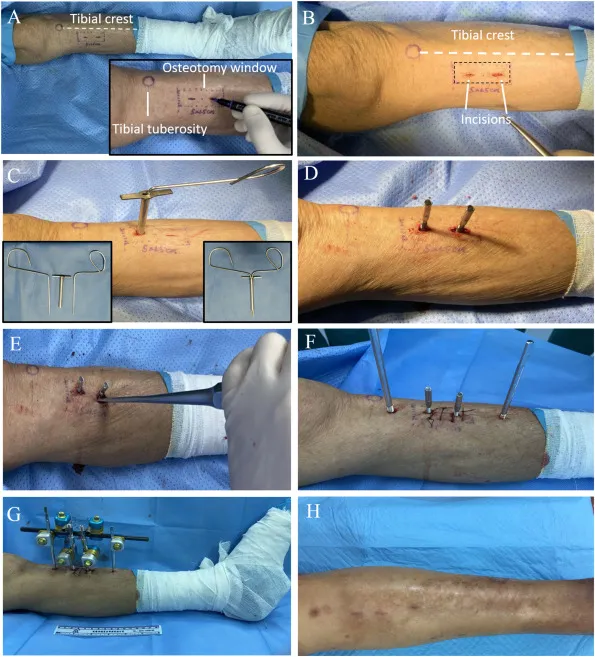BioDynamik Named One of Southern California’s “Cool Companies” for 2025
Lake Forest, CA – BioDynamik Inc., a pioneer in regenerative medical technology for limb salvage and chronic wound repair, has been...

Hippocrates (460-370 BC), the ancient Greek physician known as the "Father of Modern Medicine", believed that the human body has the power to heal itself. He believed that the natural healing force within each person is the greatest force in getting well.
Alessandro Codivilla first described distraction osteogenesis (DO) in 1905 as a surgical technique to lengthen limbs that were abnormally short due to injury, disease, or malformation. DO is a bone regeneration process that involves gradually separating bone segments to create a callus, which is then stretched to form new bone.


The "Law of Tension-Stress" refers to a biological principle stating that applying slow, gradual tension (pulling force) to living tissues can stimulate their growth and regeneration by activating cellular processes, essentially promoting the development of new tissue where tension is applied.
Ilizarov discovered that transverse distraction has strong potential for vascular regeneration. His method, which uses an external fixator to gently pull on tissue, promotes the growth of new blood vessels, nerves, and muscle. This technique proved effective for treating Buerger's disease and chronic limb ischemia. By stimulating neovascularization the method restores circulation, improves tissue viability, and can prevent amputation.


TTT surgery is an extension of the Ilizarov technique. Based on the law of tension-stress, its primary function is to rebuild microcirculation which can relieve ischemic symptoms and promote wound healing. TTT technique is mainly used in the treatment of chronic ischemic diseases of the lower extremities.
By 2019, Dr. Qikai Hua had successfully treated over 500 cases of diabetic foot gangrene using the TTT technique. The remarkable effects of this approach—improving local blood supply and promoting tissue repair—have been consistently verified in the treatment of ischemic diseases.



With its introduction to the Western world, TTT brings a breakthrough for ischemic foot ulcers, showcasing the same proven efficacy observed in China.







Lake Forest, CA – BioDynamik Inc., a pioneer in regenerative medical technology for limb salvage and chronic wound repair, has been...
BioDynamik Announces New FDA 510(k) Clearance for XT3 System BioDynamik Inc., an innovative engineering-focused company specializing in advanced orthopedic procedures...
FOR IMMEDIATE RELEASE BioDynamik Awarded Prestigious Grant from the National Science Foundation Lake Forest, CA – December 11, 2024 – BioDynamik...

We are pleased to highlight more initial data with Tibial Cortex Transverse Transport (TTT). This novel approach offers a potential additional intervention for patients with chronic limb-threatening ischemia (CLTI) and severe diabetic foot ulcers (DFUs).

A recent study published in ScienceDirect has explored the role of tibial transport in limb preservation and wound healing for patients with diabetes and peripheral artery disease8.

Diabetic foot ulcers (DFUs) represent one of the most significant challenges in managing diabetes-related complications. Affecting millions worldwide, DFUs lead to substantial morbidity, healthcare costs, and a heightened risk of amputation. While traditional therapies like debridement, offloading, and vascular interventions have their place, innovative solutions are crucial to improve outcomes. A recent study by Yuan

Diabetic foot ulcers (DFUs) are a common and severe complication of diabetes, often leading to lower extremity amputations. Traditional treatments, while varied, do not always prevent the progression of these ulcers, particularly in more advanced stages.

Introduction Chronic limb-threatening ischemia (CLTI) is a severe condition with high risks of amputation and mortality. A groundbreaking study by Ding et al. (2024) has revealed the potential of combining Tibial Cortex Transverse Transport (TTT) with Endovascular Therapy (EVT) to enhance outcomes for patients suffering from CLTI. Key Findings

Diabetic foot ulcers (DFUs) are a significant global health concern, affecting a substantial number of individuals with diabetes. These ulcers often present challenges in achieving healing, leading to prolonged non-healing and, in some cases, necessitating amputation.

A recent study published in the Chinese Journal of Tissue Engineering Research presents an innovative approach for treating diabetic foot ulcers through periosteal distraction. This technique, grounded in Ilizarov’s tension

The study by Liao et al. (2023) suggests significant differences in early hemodynamics after tibial transverse transport in patients with diabetic foot, focusing on those with nonarterial stenosis versus arterial stenosis. High-frequency color Doppler ultrasonography and laser Doppler flowmetry were used to assess changes. The study contributes to our understanding of diabetic foot treatment by highlighting variations in blood flow and plantar microcirculation between these patient groups. For more detailed information, please refer to the study

Diabetic foot, a severe complication of diabetes, poses a significant challenge in medical treatment and patient care. Traditional approaches have often focused on managing symptoms and preventing further deterioration, but recent research offers a glimpse...

More on what I’d like to call “therapeutic distress signals”. Like NPWT, which works on skin matrices, could Ilizarov, properly used, stimulate angiogenesis at a distance? Even more data supporting a potential advance in diabetic wound...

A recent study published in the Chinese Journal of Tissue Engineering Research presents an innovative approach for treating diabetic foot ulcers through periosteal distraction. This technique, grounded in Ilizarov’s tension

Congratulations to Chang and coworkers on this effort. This makes us want to reach back to work from our team a dozen or so years ago, where we failed to really explore this fascinating area of creating, in essence, a distress signal